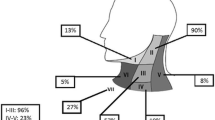Background:
The TNM classification system of tumor stage does not always reflect the actual tumor mass present at diagnosis. This study aimed at evaluating the prognostic value of volumetric data regarding survival in head and neck cancer patients being treated with either cisplatin or carboplatin administered concomitantly with radiotherapy.
Patients and Methods: We retrospectively analyzed 107 patients suffering from squamous cell carcinoma of the head and neck in a Greek-German cooperational study (see Table 1). All patients were treated by radiotherapy and concomitant chemotherapy. 65 patients received chemotherapy with carboplatin and 42 with cisplatin. More than 6,200 CT scans were analyzed by digitalization of contours which subsequently led to the computation of the tumor volume (primary and macroscopic lymph node metastases).
Results: Median follow-up was 43 months and median survival 30 months. Median initial tumor volume was 32.5 ml (range 2.1–220.1 ml) in the carboplatin and 44.4 ml (range 3.2–202.5 ml) in the cisplatin group (see Figure 1). After treatment, tumor volumes did not differ significantly (median of 3.1 ml [range 0.0–167.1 ml] and 3.5 ml [range 0.0–166.0 ml], respectively). 41 patients (63.1%) died in the carboplatin group and 22 patients (52.4%) in the cisplatin group (see Figure 2). Pretherapeutic tumor volume was prognostic with respect to survival while TNM classification and age were not. Pretherapeutic tumor volume was negatively and percent decrease in tumor volume positively associated with survival (see Tables 2 and 3).
Conclusion: Knowledge of the initial tumor volume adds valuable information in terms of prognosis. Initial tumor volume should be included in all future clinical trials regarding head and neck cancer patients.
Hintergrund:
Das TNM-Tumorklassifikationssystem repräsentiert nicht immer die tatsächliche Tumormasse bei Diagnose. Diese Studie hatte die Überprüfung der prognostischen Wertigkeit volumetrischer Analysen bezüglich des Überlebens bei Patienten mit Kopf-Hals-Tumoren, die radiotherapeutisch und mit begleitender Chemotherapie (Cisplatin oder Carboplatin) behandelt wurden, zur Zielsetzung.
Patienten und Methodik: Wir analysierten retrospektiv 107 Patienten mit Kopf-Hals-Tumoren im Rahmen einer griechisch-deutschen Kooperationsstudie (s. Tabelle 1). Alle Patienten erhielten eine Radiotherapie, 65 Patienten zusätzlich eine Carboplatin-, 42 Patienten eine Cisplatin-Chemotherapie. Mehr als 6 200 CT-Bilder wurden mittels Digitalisierung der Konturen bearbeitet, sodass daraus das Tumorvolumen (Primarius inkl. makroskopischer Lymphknotenmetastasen) berechnet werden konnte.
Ergebnisse: Das mediane Follow-up betrug 43 Monate, das mediane Überleben 30 Monate. Das mediane initiale Tumorvolumen betrug 32,5 ml (2,1–220,1 ml) in der Carboplatin- und 44,4 ml (3,2–202,5 ml) in der Cisplatin-Gruppe (s. Abbildung 1). Nach Beendigung der Therapie unterschieden sich die Tumorvolumina nicht signifikant (Median von 3,1 ml [0,0–167,1 ml] bzw. 3,5 ml [0,0–166,0 ml]). In der Carboplatin-Gruppe starben 41 (63,1%) der Patienten, in der Cisplatin-Gruppe 22 (52,4%) (s. Abbildung 2). Das prätherapeutische Tumorvolumen war im Gegensatz zur TNM-Klassifikation prognostisch bezüglich des Überlebens. Das prätherapeutische Tumorvolumen war negativ, die prozentuale Abnahme des Tumorvolumens positiv mit dem Überleben assoziiert (s. Tabellen 2 und 3).
Schlussfolgerung: Das initiale Tumorvolumen ist ein wichtiger Prognostikator des Überlebens und sollte in alle zukünftigen Studien bezüglich Kopf-Hals-Tumoren inkludiert werden.
Similar content being viewed by others
Author information
Authors and Affiliations
Additional information
Received: February 28, 2002; accepted: January 17, 2003
Correspondence Address Prof. Dr. Dr. Nikolaos Zamboglou, Strahlenklinik Klinikum Offenbach, Starkenburgring 66, 63069 Offenbach a. M., Germany, Phone (+49/69) 8405-3335, Fax -3334, E-Mail: n.zamboglou@t-online.de
Rights and permissions
About this article
Cite this article
Kurek, R., Kalogera-Fountzila, A., Muskalla, K. et al. Usefulness of Tumor Volumetry as a Prognostic Factor of Survival in Head and Neck Cancer. Strahlenther Onkol 179, 292–297 (2003). https://doi.org/10.1007/s00066-003-1017-0
Issue Date:
DOI: https://doi.org/10.1007/s00066-003-1017-0




